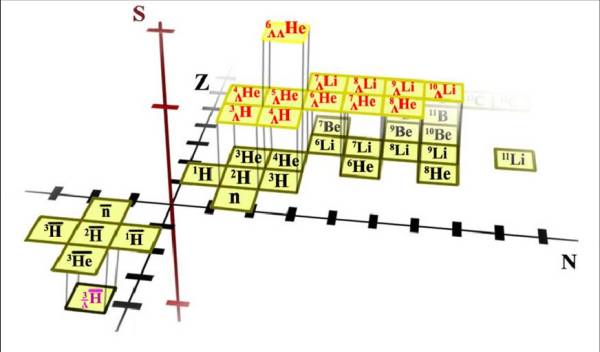






The Shanghai Institute of Applied Physics researchers are part of a team of international scientists who have discovered the most massive antinucleus discovered to date. They are part of an international team of scientists studying high-energy collision of gold ions at the Relativistic Heavy Ion Collidor (RHIC), a 2.4 mile-circumference particle accelerator at the U.S Department of Energy's Brookhaven National Laboratory in Upton, N.Y. The team has published evidence of the most massive antinucleus discovered to date. The new antinucleus, discovered at RHIC’s STAR detector, is a negatively charged state of antimatter containing an antiproton, an antineutron, and an anti-Lambda particle. It is also the first antinucleus containing an anti-strange quark. The results will be published by Science and it appears online by Science Express on March 4, 2010.
“This experimental discovery may have unprecedented consequences for our view of the world,” commented theoretical physicist Horst Stoecker, Vice President of the Helmholtz Association of German National Laboratories. “This antimatter pushes open the door to new dimensions in the nuclear chart — an idea that just a few years ago, would have been viewed as impossible.”
The discovery may help elucidate models of neutron stars and opens up exploration of fundamental asymmetries in the early universe. It may also have implications for cosmic ray experiments searching for new physics such as dark matter, which is thought to be responsible for about a quarter of the mass of the universe.
New nuclear terrain

All terrestrial nuclei are made of protons and neutrons (which in turn contain only up and down quarks). The standard Periodic Table of Elements is arranged according to the number of protons, which determine each element’s chemical properties. Physicists use a more complex, three-dimensional chart to also convey information on the number of neutrons, which may change in different isotopes of the same element, and a quantum number known as “strangeness”, which depends on the presence of strange quarks (see diagram). Nuclei containing one or more strange quarks are called hypernuclei.
For all ordinary matter, with no strange quarks, the strangeness value is zero and the chart is flat. Hypernuclei appear above the plane of the chart. The new discovery of strange anti-matter with an anti-strange quark (antihypernuclei) marks the first entry below the plane.
This study of the new antihypernucleus also yields a valuable sample of normal hypernuclei, and has implications for our understanding of the structure of collapsed stars.
“The strangeness value could be non-zero in the core of collapsed stars,” said Jinhui Chen, one of the lead authors, a staff scientist at Professor Yu-Gang Ma’s group, Shanghai Institute of Applied Physics, Chinese Academy of Sciences (CAS), “so the present measurements at RHIC will help us distinguish between models that describe these exotic states of matter.”
“While the findings are the work of hundreds of scientists from the STAR collaboration, this discovery would not have happened without Chen's diligent research.", said Ma, “Chen showed his scientific talent when he was a PhD student in Shanghai Institute of Applied Physics under my guidance. He played leading role in exploring the partonic collectivity and properties of multi-strange particles (hyperons) from the STAR data, especially for phi-meson, which is composed of strange-quark and anti-strange quark. His good experience in these hyperons’ data analysis helps him a lot for hunting the new antihypernucleus”. Right after Jinhui Chen got his PhD in Shanghai Institute of Applied Physics in 2008, he has become a tenured staff scientist in his home graduated institute since July, 2008.
The findings also pave the way towards exploring violations of fundamental symmetries between matter and antimatter that occurred in the early universe, making possible the very existence of our world.
Collisions at RHIC fleetingly produce conditions that existed a few microseconds after the Big Bang, which scientists believe gave birth to the universe as we know it some 13.7 billion years ago. In both nucleus-nucleus collisions at RHIC and in the Big Bang, quarks and antiquarks emerge with equal abundance. At RHIC, among the collision fragments that survive to the final state, matter and antimatter are still close to equally abundant, even in the case of the relatively complex antinucleus and its normal-matter partner featured in the present study. In contrast, antimatter appears to be largely absent from the present-day universe.
“Understanding precisely how and why there’s a predominance of matter over antimatter remains a major unsolved problem of physics,” said Brookhaven physicist Zhangbu Xu, another one of the lead authors. “A solution will require measurements of subtle deviations from perfect symmetry between matter and antimatter, and there are good prospects for future antimatter measurements at RHIC to address this key issue.”
The STAR team has found that the rate at which their heaviest antinucleus is produced is consistent with expectations based on a statistical collection of antiquarks from the soup of quarks and antiquarks generated in RHIC collisions. Extrapolating from this result, the experimenters believe they should be able to discover even heavier antinuclei in upcoming collider running periods. Theoretical physicist Stoecker and his team have predicted that strange nuclei around double the mass of the newly discovered state should be particularly stable.
RHIC’s STAR collaboration is now poised to resume antimatter studies with greatly enhanced capabilities. The scientists expect to increase their data by about a factor of 10 in the next few years.
The STAR collaboration is composed of 54 institutions from 13 countries. In China, they are Shanghai Institute of Applied Physics-CAS, University of Science and Technology of China, Tsinghua University, Central China Normal University, Institute of Modern Physics-CAS, Shandong University etc. Research at RHIC is funded primarily by the U.S. Department of Energy’s Office of Science and by various national and international collaborating institutions, including National Natural Science Foundation of China, Chinese Academy of Science, Ministry of Science and Technology, Ministry of Education of the People’s Republic of China.